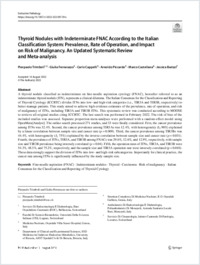Thyroid nodules with indeterminate FNAC according to the Italian classification system : prevalence, rate of operation, and impact on risk of malignancy : an updated systematic review and meta-analysis
- Trimboli, Pierpaolo ORCID Servizio Di Endocrinologia E Diabetologia, Ente Ospedaliero Cantonale (EOC), Bellinzona, Switzerland - Faculty of Biomedical Sciences, Università della Svizzera italiana, Switzerland
- Ferrarazzo, Giulia Medicina Nucleare, Ospedale Villa Scassi Hospital, Genoa, Italy
- Cappelli, Carlo ORCID Department of Clinical and Experimental Sciences, SSD Medicina Ad Indirizzo Endocrino-Metabolico, University of Brescia, ASST Spedali Civili Di Brescia, Brescia, Italy
- Piccardo, Arnoldo ORCID Struttura Complessa Di Medicina Nucleare, E.O. Ospedali Galliera, Genoa, Italy
- Castellana, Marco Ambulatorio Di Endocrinologia E Diabetologia, Poliambulatorio Di Monopoli, Azienda Sanitaria Locale Bari, Monopoli, Italy
- Barizzi, Jessica Servizio Di Citopatologia, Istituto Cantonale Di Patologia, Locarno, Switzerland
- 2022
Published in:
- Endocrine pathology. - 2022, vol. 33, p. 457–471
Fine-needle aspiration (FNAC)
Indeterminate nodules
Thyroid
Carcinoma
Risk of malignancy
Italian consensus for the classification and reporting of thyroid cytology
English
A thyroid nodule classified as indeterminate on fine-needle aspiration cytology (FNAC), hereafter referred to as an indeterminate thyroid nodule (ITN), represents a clinical dilemma. The Italian Consensus for the Classification and Reporting of Thyroid Cytology (ICCRTC) divides ITNs into low- and high-risk categories (i.e., TIR3A and TIR3B, respectively) to better manage patients. This study aimed to achieve high-evidence estimates of the prevalence, rate of operation, and risk of malignancy of ITNs, including TIR3A and TIR3B ITNs. This systematic review was conducted according to MOOSE to retrieve all original studies citing ICCRTC. The last search was performed in February 2022. The risk of bias of the included studies was assessed. Separate proportion meta-analyses were performed with a random-effect model using OpenMeta [Analyst]. The online search processed 271 studies, and 33 were finally considered. First, the cancer prevalence among ITNs was 32.4%. Second, the cancer prevalence among TIR3As was 12.4%, with heterogeneity (I2 90%) explained by a linear correlation between sample size and cancer rate (p = 0.009). Third, the cancer prevalence among TIR3Bs was 44.4%, with heterogeneity (I2 75%) explained by the inverse correlation between sample size and cancer rate (p = 0.031). Fourth, the prevalence of ITNs, TIR3A, and TIR3B among FNACs was 29.6%, 12.6%, and 12.9%, respectively, with sample size and TIR3B prevalence being inversely correlated (p = 0.04). Fifth, the operation rates of ITNs, TIR3A, and TIR3B were 54.3%, 48.3%, and 75.2%, respectively, and the sample size and TIR3A operation rate were inversely correlated (p = 0.010). These data strongly support the division of ITNs into low- and high-risk subcategories. Importantly for clinical practice, the cancer rate among ITNs is significantly influenced by the study sample size.
- Collections
- Language
-
- English
- Classification
- Medicine
- License
- Open access status
- hybrid
- Identifiers
-
- DOI 10.1007/s12022-022-09729-x
- ARK ark:/12658/srd1324961
- Persistent URL
- https://n2t.net/ark:/12658/srd1324961
Statistics
Document views: 133
File downloads:
- Trimboli_2022_Spri_endocrpath: 193
